PEST AND DISEASES AFFECTING APPLE TREE LEAVES
CURLED AND DISTORTED LEAVES, BLACK STICKY PATCHES ON LEAVES
This is caused by aphids, tiny little insects which are often first noticed on the underside of new tender leaves. The black sticky is been excreted by the aphids and has been infected by mould. Although unlikely to cause severe damage aphids do need to be controlled in order to ensure a good crop of apples.
SOME LEAVES COVERED IN WHITE POWDER
The white powder (looks like a fine layer of talcum powder) is mould or mildew, the disease is known as powdery mildew.
Infected leaves may be slightly smaller than normal and may be distorted. It can spread to fruit and even twigs and branches. It first becomes noticeable when young leaves emerge in spring.
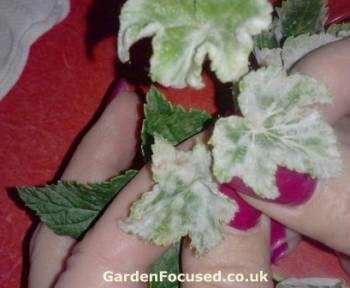

Leaves affected by Powdery Mildew
YELLOW / OLIVE AREAS ON LEAVES
Scab not only affects the leaves of apple trees it also affects the fruit so check the fruit section lower down this page to confirm that you have this fungal disease. As well as yellow and dark green spots on the underside and top of leaves you may also see groups of the spores growing as small brown velvety mounds on the underside of leaves. Go to our dedicated apple scab page for treatment and prevention methods.


Leaf affected by Apple Scab
SMALL GREEN CATERPILLARS ON LEAVES, LEAVES AND BUDS DAMAGED
This pest is the Winter Moth and will normally become apparent in late March to May. The first indication will be tiny caterpillars on and around fruit and leaf buds. They may spin silken threads and hang from the tree twigs. They then grow into larger caterpillars and will eat leaves, buds and almost all parts of the foliage. Consult our Winter Moth page
for more details.
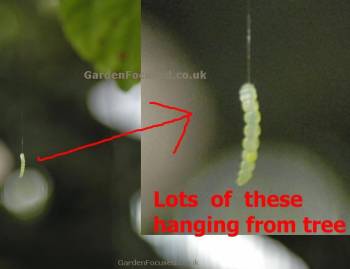

Winter Moth Caterpillar hanging by a thread
PEST AND DISEASES AFFECTING APPLE TREE BRANCHES AND TRUNK
BARK CRACKED, PATCHES OF BARK SUNKEN DOWN
Canker is a fungal infection which enters tree wood at the site of existing damage, normally caused by bad pruning techniques although damage by woolly aphid (see above) can also allow the fungus to enter the tree. It can affect individual branches, stems and even more seriously the main tree trunk.
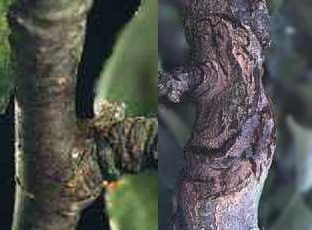
BRANCHES HAVE IRREGULAR LUMPS ON THEM
See the picture below for the signs of galls, also known as burls. These lumps are due to genetic changes in the tree caused by bacteria entering the wood, often at the site of a wound. In some cases they can be so bad that the tree is killed but in many cases there are no noticeable side effects.
The only permanent solution is to destroy the tree. The bacteria will remain in the soil for two three more years.

![]() Apple tree stem affected by Galls
Apple tree stem affected by Galls
BRANCHES HAVE ELONGATED WHITE FLUFFY AREAS ON THEM
The visible white fluffy areas are restricted to stems and branches, occasionally the main trunk. The areas tend to be elongated rather than round. Where additional infections occur the fluffy material may become spotted black or grey. This is woolly aphid and although unlikely to kill an apple tree it will encourage other infections such as canker which can severely damage and kill an apple tree.
Apple tree stem affected by Woolly Aphid
PEST AND DISEASES AFFECTING APPLE TREE FRUIT
INSIDE OF THE APPLES HAS A BROWN TUNNEL IN IT
Unless you have experience of Codling Moth it’s likely the first sign of damage will only be apparent when you cut open the apple.
There will be a tunnel in the fruit of varying length which is brown in appearance and filled with excrement from the caterpillar. This damage has been caused by the caterpillar stage of the Codling Moth. Click here for our detailed page on identifying and treating this pest.
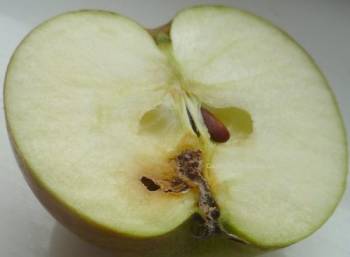

Apple affected by Codling Moth
SKIN HAS BROWN, PIN HEAD SIZED MARKS. FRUIT TASTES BITTER
In addition the flesh may have similar marks in it. If you cut the apple in half the marks on the skin will also be in the flesh, sometimes right to the middle. This is without doubt caused by bitter pit. Click here for more identification and treatment details.
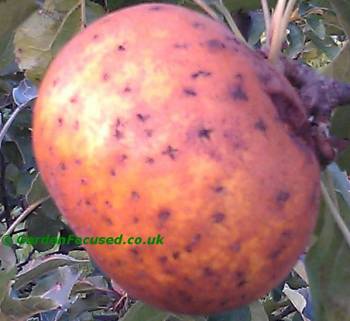

Apple affected by Bitter Pit
SKIN HAS BROWN RASED OR SUNKEN AREAS
The fruits have greyish, slightly raised or sunken areas on the surface. This is most likely caused by apple scab. The affected area will not grow with rest of the apple, causing it to split eventually, providing an ideal site for other infections to enter. See also problems affecting leaves above because scab affects the leaves as well.
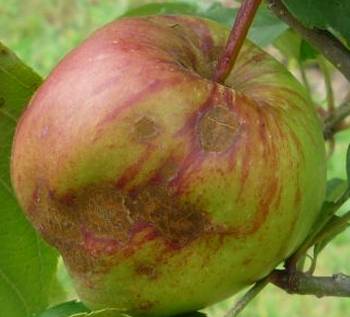

Apple affected by Scab
BLOSSOM WILT
Blossom Wilt affects fruit trees including apples, pears, plums and cherries. It is a fungal disease (Monilinia laxa and Monilinia fructigena) which has the following symptoms:
- Blossoms wilt then shrivel up and become dried out.
- Leaves near the blossoms (on the fruiting spurs) also turn brown and shrivel up.
- If conditions are damp, the affected leaves will have small, light brown, fungal raised areas on them.
- If any fruit manages to survive it will turn brown and rot.
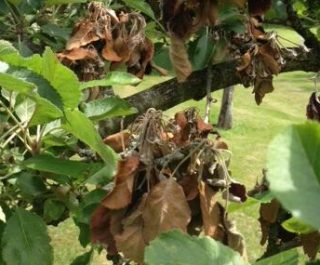
Damage by Blossom Wilt
There are no chemical controls available to UK gardeners to control this fungal infection.
Non-chemical control is based on pruning off any damaged blossoms including the fruiting spur they are on. Burn them, do not put them on the compost heap. Do the same with any fallen leaves. The idea is to minimise the spread of the spores and hopefully prevent them over-wintering and re-infecting the tree the next year.
EUROPEAN RED MITE
Lots of small, red eggs on the bark of the tree branches. Commonly, but not always, these are found in the join between one branch and another. The picture below (courtesy of David H) can be used to identify them.
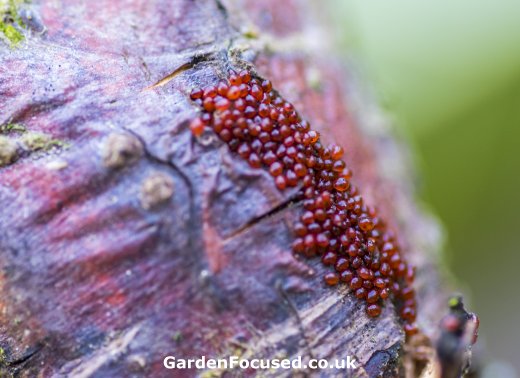
![]()
The red eggs are from the European Red Mite. Because I have never encountered them personally I can’t really offer advice as to how to control them. However I do know that they are eggs which will hatch out in spring and become tiny red mites.
These will damage the leaves of your apple tree. I would certainly scrape the eggs off immediately before they hatch and take a close look around the tree for more of them. When the eggs hatch they loose their colour so this will give you an idea of the scale of the problem this year.
To the best of my knowledge the European Red Mite is not connected with the more common Red Spider Mite. More information can be found on the link here.
COMMENTS / QUESTIONS LEFT BY OUR READERS
We have moved the Apple Tree pests and diseases comments and questions section to its own page which can be visited by clicking here. On that page you can view all the previously asked questions / answers / comments and also ask any new questions of your own.
The questions and answers page contains a large amount of additional information about apple tree problems.
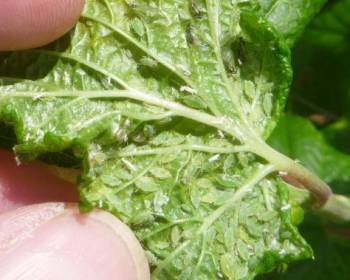
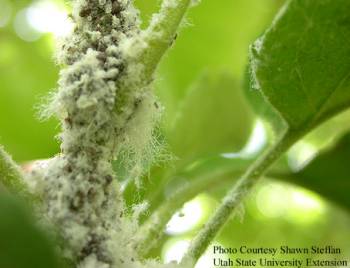
Rootstocks and Size
Guide to Planting
Care Plan
Pruning Apple Trees
Harvest and Storage
Pests and Disease
Pollination Groups
APPLE TREE PESTS AND DISEASES
By David Marks
Like all plants apples suffer from their fair share of pests and diseases. The good news though is that selecting the correct variety for your area of the UK and your particular soil conditions can reduce the risk of problems considerably.
This page with picture and clear descriptions will help you identify the common pests and diseases although if you want advice on how to prevent them in the first place then the page here has more specific information on preventative measures.
The article below lists pests and diseases which affect the leaves, branches, fruit, blossom and the roots.